Agroforestry Systems: A Systematic Review Focusing on Traditional Indigenous Practices, Food and Nutrition Security, Economic Viability, and the Role of Women
Abstract
1. Introduction
2. Material and Methods
2.1. Article Selection
2.2. Data Analysis
3. Results
3.1. Quantitative Analysis
3.2. Qualitative Analysis
3.2.1. Empirical Methodologies for Environmental Measurement
3.2.2. Empirical Methodologies for Economic Measurement
4. Discussion
4.1. Food Security
4.2. The Role of Women
4.3. Indigenous Communities
5. Concluding Remarks
Author Contributions
Funding
Acknowledgments
Conflicts of Interest
References
- De Araújo, I.M.M.; da Costa Oliveira, Â.G.R. Agronegócio E Agrotóxicos: Impactos À Saúde Dos Trabalhadores Agrícolas No Nordeste Brasileiro. Trab. Educ. Saúde 2016, 15, 117–129. [Google Scholar] [CrossRef]
- Matzembacher, D.E.; Meira, F.B. Mercantilização & contramovimento: Agricultura sustentada pela comunidade (CSA): Estudo de caso em Minas Gerais, Brasil. Organ. Soc. 2020, 27, 396–430. [Google Scholar] [CrossRef]
- Ribeiro, É.C.; Gastal, M.; Melo, T. Tipifi cação de sistemas de produção em assentamento de reforma agrária no município de Unaí, MG. Rev. Interações 2018, 19, 171–180. [Google Scholar] [CrossRef]
- Ribeiro, H.; Jaime, P.C.; Ventura, D. Alimentação e sustentabilidade. Estud. Adv. 2017, 31, 185–198. [Google Scholar] [CrossRef]
- CONSEA. Tekoha: Direito dos Povos Guarani e Kaiowá. 2017. Available online: http://www4.planalto.gov.br/consea/publicacoes/site/tekoha-direitos-dos-povos-guarani-e-kaiowa (accessed on 27 September 2019).
- FAO. Panorama de La Seguridad Alimentaria y Nutricional. 2018. Available online: http://www.fao.org/3/CA2127ES/CA2127ES.pdf (accessed on 27 September 2019).
- Lima, A.C. O governo dos índios sob a gestão do SPI. In História dos Índios no Brasil; Cunha, M.C.d., Ed.; Cia das Letras: São Paulo, Brazil; Secretaria Municipal de Cultura: São Paulo, Brazil; FAPESP: São Paulo, Brazil, 1992. [Google Scholar]
- Mota, J.G.B.; Cavalcante, T.L.V. Reserva Indígena de Dourados: História e Desafios Contemporâneos; Karywa: São Leopoldo, Brazil, 2019. [Google Scholar]
- Batista, K.M.; Milioli, G.; Citadini-Zanette, V. Saberes Tradicionais De Povos Indígenas Como Referência De Uso E Conservação Da Biodiversidade: Considerações Teóricas Sobre O Povo Mbya Guarani. Ethnoscientia 2020, 5, 1–17. [Google Scholar] [CrossRef]
- Da Silva, A.P. Traditional tupi knowledge: Being together, learning, nhembojera. Cad. Cedes 2019, 39, 379–396. [Google Scholar] [CrossRef]
- Altieri, M. Agroecologia, Agricultura Camponesa E Soberania Alimentar. Rev. Nera 2010, 13, 22–32. [Google Scholar]
- Altieri, M.A.; Nicholls, C.I.; Montalba, R. Technological approaches to sustainable agriculture at a crossroads: An agroecological perspective. Sustainability 2017, 9, 349. [Google Scholar] [CrossRef]
- Aguilera, E.; Díaz-Gaona, C.; García-Laureano, R.; Reyes-Palomo, C.; Guzmán, G.I.; Ortolani, L.; Sánchez-Rodríguez, M.; Rodríguez-Estévez, V. Agroecology for adaptation to climate change and resource depletion in the Mediterranean region. A review. Agric. Syst. 2020, 181, 102809. [Google Scholar] [CrossRef]
- Kansanga, M.M.; Luginaah, I.; Bezner Kerr, R.; Lupafya, E.; Dakishoni, L. Beyond ecological synergies: Examining the impact of participatory agroecology on social capital in smallholder farming communities. Int. J. Sustain. Dev. World Ecol. 2020, 27, 1–14. [Google Scholar] [CrossRef]
- Nodari, R.O.; Guerra, M.P. A agroecologia: Estratégias de pesquisa e valores. Estud. Av. 2015, 29, 183–207. [Google Scholar] [CrossRef]
- Do Carmo Martinelli, G.; Schlindwein, M.M.; Padovan, M.P.; Gimenes, R.M.T. Decreasing uncertainties and reversing paradigms on the economic performance of agroforestry systems in Brazil. Land Use Policy 2019, 80, 274–286. [Google Scholar] [CrossRef]
- Falkowski, T.B.; Chankin, A.; Diemont, S.A.W.; Pedian, R.W. More than just corn and calories: A comprehensive assessment of the yield and nutritional content of a traditional Lacandon Maya milpa. Food Secur. 2019, 10, 389–404. [Google Scholar] [CrossRef]
- Ferrante, L.; Fearnside, P.M. Protect Indigenous peoples from COVID-19. Science 2020, 368, 251–253. [Google Scholar] [CrossRef]
- ONU—Organização das Nações Unidas. Available online: http://www.nacoesunidas.org (accessed on 18 September 2020).
- Zavaleta, C. Readers respond. Nature 2020, 580, 185. [Google Scholar] [CrossRef]
- Sen, A. Desenvolvimento Como Liberdade, 6th ed.; Companhia das Letras: São Paulo, Brazil, 2000. [Google Scholar]
- Robinson Trápaga, D.G.; Díaz-Carrión, I.A.; Cruz Hernández, S. Propuesta de un modelo para el empoderamiento de la mujer rural e indígena a través de grupos productivos y microempresas sociales. Retos 2019, 9, 91–108. [Google Scholar] [CrossRef]
- Chamberlain, J.L.; Darr, D.; Meinhold, K. Rediscovering the contributions of forests and trees to transition global food systems. Forests 2020, 11, 1098. [Google Scholar] [CrossRef]
- Duffy, C.; Toth, G.G.; Hagan, R.P.O.; McKeown, P.C.; Rahman, S.A.; Widyaningsih, Y.; Sunderland, T.C.H.; Spillane, C. Agroforestry contributions to smallholder farmer food security in Indonesia. Agrofor. Syst. 2021, 8, 21. [Google Scholar] [CrossRef]
- Moreno-Calles, A.I.; Casas, A.; Rivero-Romero, A.D.; Romero-Bautista, Y.A.; Rangel-Landa, S.; Fisher-Ortíz, R.A.; Alvarado-Ramos, F.; Vallejo-Ramos, M.; Santos-Fita, D. Ethnoagroforestry: Integration of biocultural diversity for food sovereignty in Mexico. J. Ethnobiol. Ethnomed. 2016, 12, 1–21. [Google Scholar] [CrossRef] [PubMed]
- Reed, J.; van Vianen, J.; Foli, S.; Clendenning, J.; Yang, K.; MacDonald, M.; Petrokofsky, G.; Padoch, C.; Sunderland, T. Trees for life: The ecosystem service contribution of trees to food production and livelihoods in the tropics. For. Policy Econ. 2017, 84, 62–71. [Google Scholar] [CrossRef]
- Smith, J.; Pearce, B.D.; Wolfe, M.S. A European perspective for developing modern multifunctional agroforestry systems for sustainable intensification. Renew. Agric. Food Syst. 2012, 27, 323–332. [Google Scholar] [CrossRef]
- Sampaio, R.; Mancini, M. Estudos de revisão sistemática: Um guia para síntese. Rev. Bras. Fisioter. 2007, 11, 83–89. [Google Scholar] [CrossRef]
- Galvão, C.M.; Sawada, N.O.; Trevizan, M.A. Revisão sistemática: Recurso que proporciona a incorporação das evidências na prática da enfermagem. Rev. Lat. Am. Enferm. 2004, 12, 549–556. [Google Scholar] [CrossRef] [PubMed]
- Igarashi, W.; Corrêa Igarashi, D.C.; Borges, B.J. Revisão Sistemática E Sua Potencial Contribuição Em “Negócios, Gerenciamento E Contabilidade”. Gestão Reg. 2015, 31, 1–14. [Google Scholar] [CrossRef]
- Mapbiomas. Available online: https://plataforma.mapbiomas.org/ (accessed on 30 November 2020).
- Cerda, R.; Deheuvels, O.; Calvache, D.; Niehaus, L.; Saenz, Y.; Kent, J.; Vilchez, S.; Villota, A.; Martinez, C.; Somarriba, E. Contribution of cocoa agroforestry systems to family income and domestic consumption: Looking toward intensification. Agrofor. Syst. 2014, 88, 957–981. [Google Scholar] [CrossRef]
- Lehmann, L.M.; Smith, J.; Westaway, S.; Pisanelli, A.; Russo, G.; Borek, R.; Sandor, M.; Gliga, A.; Smith, L.; Ghaley, B.B. Productivity and economic evaluation of agroforestry systems for sustainable production of food and non-food products. Sustainability 2020, 12, 5429. [Google Scholar] [CrossRef]
- Machado, D.D.E.O. A Agrobiodiversidade De Quintais Agroflorestais Em Propriedades Agrícolas Familiares Na Br 174, Ramal Do Pau-Rosa, Dissertação; Instituto Nacional de Pesquisas da Amazônia—INPA: Manaus, Brazil, 2016; p. 96. [Google Scholar]
- Bezerra, J.D.P. The Role of Urban Yards in Food Security, Well-Being and Biodiversity Conservation [O Papel dos Quintais Urbanos na Segurança Alimentar, bem Estar e Conservação da Biodiversidade]. Dissertação de Mestrado, Universidade Federal do Rio Grande do Norte, Natal, Brazil, 2014; pp. 1–86. [Google Scholar]
- Moraes, M.H.C.D.S. Agrobiodiversidade dos Quintais e Socioeconomia dos Agroecossitemas Familiares da Cooperativa D’ Iritua. Dissertação de Mestrado, Universidade Federal Rural da Amazônia, Belém, Pará, Brazil, 2017. [Google Scholar]
- Gosling, E.; Reith, E.; Knoke, T.; Paul, C. A goal programming approach to evaluate agroforestry systems in Eastern Panama. J. Environ. Manag. 2020, 261, 110248. [Google Scholar] [CrossRef]
- Rayol, B.P.; Do Vale, I.; Miranda, I.S. Tree and palm diversity in homegardens in the Central Amazon. Agrofor. Syst. 2019, 93, 515–529. [Google Scholar] [CrossRef]
- Cardozo, E.G.; Muchavisoy, H.M.; Silva, H.R.; Zelarayán, M.L.C.; Leite, M.F.A.; Rousseau, G.X.; Gehring, C. Species richness increases income in agroforestry systems of eastern Amazonia. Agrofor. Syst. 2015, 89, 901–916. [Google Scholar] [CrossRef]
- Larios, C.; Casas, A.; Vallejo, M.; Moreno-Calles, A.I.; Blancas, J. Plant management and biodiversity conservation in Náhuatl homegardens of the Tehuacán Valley, Mexico. J. Ethnobiol. Ethnomed. 2013, 9, 1–16. [Google Scholar] [CrossRef]
- Tadesse, E.; Abdulkedir, A.; Khamzina, A.; Son, Y.; Noulèkoun, F. Contrasting species diversity and values in home gardens and traditional parkland agroforestry systems in ethiopian sub-humid lowlands. Forests 2019, 10, 266. [Google Scholar] [CrossRef]
- Fifanou, V.G.; Ousmane, C.; Gauthier, B.; Brice, S. Traditional agroforestry systems and biodiversity conservation in Benin (West Africa). Agrofor. Syst. 2011, 82, 1–13. [Google Scholar] [CrossRef]
- George, M.V.; Christopher, G. Structure, diversity and utilization of plant species in tribal homegardens of Kerala, India. Agrofor. Syst. 2020, 94, 297–307. [Google Scholar] [CrossRef]
- Brandt, R.; Zimmermann, H.; Hensen, I.; Mariscal Castro, J.C.; Rist, S. Agroforestry species of the Bolivian Andes: An integrated assessment of ecological, economic and socio-cultural plant values. Agrofor. Syst. 2012, 86, 1–16. [Google Scholar] [CrossRef]
- Cotta, J.N. Revisiting Bora fallow agroforestry in the Peruvian Amazon: Enriching ethnobotanical appraisals of non-timber products through household income quantification. Agrofor. Syst. 2017, 91, 17–36. [Google Scholar] [CrossRef]
- Vallejo, M.; Casas, A.; Blancas, J.; Moreno-Calles, A.I.; Solís, L.; Rangel-Landa, S.; Dávila, P.; Téllez, O. Agroforestry systems in the highlands of the Tehuacán Valley, Mexico: Indigenous cultures and biodiversity conservation. Agrofor. Syst. 2014, 88, 125–140. [Google Scholar] [CrossRef]
- Mukul, S.A.; Saha, N. Conservation benefits of tropical multifunctional land-uses in and around a forest protected area of Bangladesh. Land 2017, 6, 2. [Google Scholar] [CrossRef]
- Fouladbash, L.; Currie, W.S. Agroforestry in Liberia: Household practices, perceptions and livelihood benefits. Agrofor. Syst. 2015, 89, 247–266. [Google Scholar] [CrossRef]
- Magcale-Macandog, D.B.; Rañola, F.M.; Rañola, R.F.; Ani, P.A.B.; Vidal, N.B. Enhancing the food security of upland farming households through agroforestry in Claveria, Misamis Oriental, Philippines. Agrofor. Syst. 2010, 79, 327–342. [Google Scholar] [CrossRef]
- Córdova, R.; Hogarth, N.J.; Kanninen, M. Sustainability of smallholder livelihoods in the Ecuadorian highlands: A comparison of agroforestry and conventional agriculture systems in the indigenous territory of Kayambi People. Land 2018, 7, 45. [Google Scholar] [CrossRef]
- Salim, M.V.d.C. Quintais Agroflorestais Em Área De Terra-Firme. Master’s Thesis, Instituto Nacional de Pesquisas da Amazônia—INPA, Manaus, Brazil, 2012. [Google Scholar]
- Agostinho, P.R.; Silva, N.J.; Soares, P.S.; Balbino1, J.A.; Padovan, M.P. Potencialidades, avanços e desafios envolvendo sistemas agroflorestais biodiversos e famílias assentadas no município de Dourados, Mato Grosso do Sul. Agroecol 2018, 13, 1–10. [Google Scholar]
- Nascimento, J.S.; Padovan, D.D.S.; Alves, J.C.; Silva, S.G.; Padovan, M.P. Sistemas agroflorestais biodiversos: Percepções e demandas de agricultores e técnicos em Mato Grosso do Sul. Agroecol 2016, 11, 1–12. [Google Scholar]
- Padovan, M.P.; Nascimento, J.S.; Pereira, Z.V.; Alves, J.C.; da Ramos, F.S. Estado da arte de sistemas agroflorestais em bases agroecológicas na região Oeste do Brasil. Agroecol 2016, 13, 12. [Google Scholar]
- Mayer, T.D.S. Sistemas Agroflorestais Biodiveros: Alternativa Viável Para Recuperação de Passivos Ambientais. Master’s Thesis, Universidade Federal da Grande Dourados, Dourados, Brazil, 2012. [Google Scholar]
- Da Silva Gonçalves, A.C.; Pontes, A.N.; de Paula, M.T.; Ferreira, P.F.; de Vasconcellos, R.C.; de Oliveira Fonseca, K. Avaliação do perfil econômico de sistemas agroflorestais nos assentamentos dos trabalhadores rurais Expedito Ribeiro e Abril Vermelho, município de Santa Bárbara-PA. Espacios 2017, 38, 6. [Google Scholar]
- Coelho, G.C. Ecosystem services in Brazilian’s southern agroforestry systems. Trop. Subtrop. Agroecosystems 2017, 20, 475–492. [Google Scholar]
- Alves, E.P.; da Silva, M.L.; de Oliveira Neto, S.N.; Barrella, T.P.; Santos, R.H.S. Economic Analisys of a Coffee-Banana System of a Family-Based Agriculture At the Atlantic Forest Zone, Brazil. Ciência Agrotecnologia 2015, 39, 232–239. [Google Scholar] [CrossRef]
- Filippin, I.L. Viabilidade Econômica do Cultivo de Nogueira Pecan em Áreas de Reserva Legal ou de Preservação Permanente. Master’s Thesis, Universidade Federal de Pelotas, Pelotas, Brazil, 2011. [Google Scholar]
- Garcia, L.T. Análise de Viabilidade Financeira de Sistemas Agroflorestais Biodiversos em Mato Grosso do sul. Master’s Thesis, Universidade Federal da Grande Dourados, Dourados, Brazil, 2017. [Google Scholar]
- Joaquim, M.S.; de Souza, Á.N.; de Souza, S.N.; Pereira, R.S.; Angelo, H. Aplicação da teoria das opções reais na análise de investimentos em sistemas Agroflorestais. Cerne 2015, 21, 439–447. [Google Scholar] [CrossRef][Green Version]
- Fahmi, M.K.M.; Dafa-Alla, D.A.M.; Kanninen, M.; Luukkanen, O. Impact of agroforestry parklands on crop yield and income generation: Case study of rainfed farming in the semi-arid zone of Sudan. Agrofor. Syst. 2018, 92, 785–800. [Google Scholar] [CrossRef]
- Belarmino, L.C.; Garcia, E.C.; Pasbsdorf, M.N.; de Oliveira, Í.P.; Belarmino, A.J. Análises econômicas dos sistemas de produção de laranja convencional, orgânico e agroflorestal no Sul do Brasil. Custos Gronegócio Line 2019, 15, 402–433. [Google Scholar]
- Cordeiro, S.A.; da Silva, M.L.; de Oliveira Neto, S.N.; Oliveira, T.M. Simulação da variação do espaçamento na viabilidade econômica de um sistema agroflorestal. Floresta Ambiente 2018, 25, 1–8. [Google Scholar] [CrossRef]
- Cordeiro, S.A. Avaliação Econômica e Simulação em Sistemas Agroflorestais. Ph.D. Thesis, Universidade Federal de Viçosa, Viçosa, Brasil, 2010; pp. 1–96. [Google Scholar]
- Weimann, C. Geração de Renda do Componente Florestal em Sistemas Agrossilvipastoris em Propriedades Familiares Do Vale Do Jaguari, Rs. Master’s Thesis, Universidade Federal de Santa Maria, Santa Maria, Brazil, 2016. [Google Scholar]
- Gustavsson, J.; Cederberg, C.; Sonesson, U. Global Food Losses and Food Waste: Extent, Causes and Prevention; FAO: Rome, Italy, 2011. [Google Scholar]
- FAO; IFAD; WFP. The State of Food Insecurity in the World: Meeting the 2015 International Hunger Targets: Taking Stock of Uneven Progress. Available online: http://www.fao.org/3/a4ef2d16-70a7-460a-a9ac-2a65a533269a/i4646e.pdf (accessed on 26 September 2020).
- FAO. La Seguridad Alimentaria y la Nutricion en el Mundo. 2019. Available online: http://www.fao.org/documents/card/en/c/ca9692en (accessed on 27 September 2019).
- Hebrok, M.; Boks, C. Household food waste: Drivers and potential intervention points for design—An extensive review. J. Clean. Prod. 2017, 151, 380–392. [Google Scholar] [CrossRef]
- Maxwell, J.J.; Howarth, J.D.; Vandergoes, M.J.; Jacobsen, G.E.; Barber, I.G. The timing and importance of arboriculture and agroforestry in a temperate East Polynesia Society, the Moriori, Rekohu (Chatham Island). Quat. Sci. Rev. 2016, 149, 306–325. [Google Scholar] [CrossRef]
- Neyra-Cabatac, N.M.; Pulhin, J.M.; Cabanilla, D.B. Indigenous agroforestry in a changing context: The case of the Erumanen ne Menuvu in Southern Philippines. For. Policy Econ. 2012, 22, 18–27. [Google Scholar] [CrossRef]
- Rahman, M.H.; Alam, K. Forest dependent indigenous communities’ perception and adaptation to climate change through local knowledge in the protected area-A Bangladesh Case Study. Climate 2016, 4, 12. [Google Scholar] [CrossRef]
- Hernández, M.Y.; Macario, P.A.; López-Martínez, J.O. Traditional agroforestry systems and food supply under the food sovereignty approach. Ethnobiol. Lett. 2017, 8, 125–141. [Google Scholar] [CrossRef]
- De Lima, R.S. Quintais Agroflorestais: Estudo de caso da Comunidade Boa Esperança, Município de Presidente Figueiredo. Master’s Thesis, Instituto Nacional de Pesquisas da Amazônia—INPA, Manaus, Brazil, 2019; pp. 1–87. [Google Scholar]
- Rahman, S.A.; Imam, M.H.; Snelder, D.J.; Sunderland, T. Agroforestry for Livelihood Security in Agrarian Landscapes of the Padma Floodplain in Bangladesh. Small-Scale For. 2012, 11, 529–538. [Google Scholar] [CrossRef]
- Roshetko, J.M.; Rohadi, D.; Perdana, A.; Sabastian, G.; Nuryartono, N.; Pramono, A.A.; Widyani, N.; Manalu, P.; Fauzi, M.A.; Sumardamto, P.; et al. Teak agroforestry systems for livelihood enhancement, industrial timber production, and environmental rehabilitation. For. Trees Livelihoods 2013, 22, 241–256. [Google Scholar] [CrossRef]
- De Almeida, L.S.; Gama, J.R.V. Quintais agroflorestais: Estrutura, composição florística e aspectos socioambientais em área de assentamento rural na Amazônia brasileira home. Ciência Florest. 2014, 59, 1041–1053. [Google Scholar] [CrossRef]
- Bose, P. Land tenure and forest rights of rural and indigenous women in Latin America: Empirical evidence. Women’s Stud. Int. Forum 2017, 65, 1–8. [Google Scholar] [CrossRef]
- Nischalke, S.M.; Abebe, M.; Wondimagegnhu, B.A.; Kriesemer, S.K.; Beuchelt, T. Forgotten Forests? Food Potential of Ancient Coffee Forests and Agroforestry Systems in the Southwestern Ethiopian Mountains, Seen Through a Gender Lens. Mt. Res. Dev. 2017, 37, 254–262. [Google Scholar] [CrossRef]
- Santafe-Troncoso, V.; Loring, P.A. Indigenous food sovereignty and tourism: The Chakra Route in the Amazon region of Ecuador. J. Sustain. Tour. 2020, 29, 392–411. [Google Scholar] [CrossRef]
- Benjamin, E.O.; Ola, O.; Buchenrieder, G. Does an agroforestry scheme with payment for ecosystem services (PES) economically empower women in sub-Saharan Africa? Ecosyst. Serv. 2018, 31, 1–11. [Google Scholar] [CrossRef]
- Gebrehiwot, M.; Elbakidze, M.; Lidestav, G. Gender relations in changing agroforestry homegardens in rural Ethiopia. J. Rural Stud. 2018, 61, 197–205. [Google Scholar] [CrossRef]
- Alves, J.C. Ka’a Kuéraha Yvaruera Oje’úva—Quintais Agroflorestais na Reserva Te’yikuê em Caarapó, Mato Grosso do Sul: Segurança Alimentar às Famílias Indígenas. Master’s Thesis, Universidade Federal Rural do Rio de Janeiro, Rio de Janeiro, Brasil, 2016. [Google Scholar]
- Villamor, G.B.; Catacutan, D.C.; Truong, V.A.T.; Thi, L.D. Tree-cover transition in Northern Vietnam from a gender-specific land-use preferences perspective. Land Use Policy 2017, 61, 53–62. [Google Scholar] [CrossRef]
- Miller, R.P.; Nair, P.K.R. Indigenous agroforestry systems in Amazonia: From prehistory to today. Agrofor. Syst. 2006, 66, 151–164. [Google Scholar] [CrossRef]
- Nair, P.K.R.; Viswanath, S.; Lubina, P.A. Cinderella agroforestry systems. Agrofor. Syst. 2017, 91, 901–917. [Google Scholar] [CrossRef]
- González, N.C.; Kröger, M. The potential of Amazon indigenous agroforestry practices and ontologies for rethinking global forest governance. For. Policy Econ. 2020, 118, 102257. [Google Scholar] [CrossRef]
- Maciel, J.D.C.; Surian, A.; Brahmllari, E.; Tarasconi, B.F.; Antonio, L. Terena agriculture and life-system. A speech and beyond Agricultura e sistema de vida Terena. Um discurso e além Agricultura y sistema de vida Terena. Un discurso y su más allá. Rev. Interações 2019, 20, 861–877. [Google Scholar] [CrossRef]
- Coq-Huelva, D.; Higuchi, A.; Alfalla-Luque, R.; Burgos-Morán, R.; Arias-Gutiérrez, R. Co-Evolution and Bio-Social Construction: The Kichwa Agroforestry Systems (Chakras) in the Ecuadorian Amazonia. Sustainability 2017, 9, 1920. [Google Scholar] [CrossRef]
- Bucheli, V.J.P.; Bokelmann, W. Agroforestry systems for biodiversity and ecosystem services: The case of the sibundoy valley in the colombian province of putumayo. Int. J. Biodivers. Sci. Ecosyst. Serv. Manag. 2017, 13, 380–397. [Google Scholar] [CrossRef]
- Ghosh-Jerath, S.; Downs, S.; Singh, A.; Paramanik, S.; Goldberg, G.; Fanzo, J. Innovative matrix for applying a food systems approach for developing interventions to address nutrient deficiencies in indigenous communities in India: A study protocol. BMC Public Health 2019, 19, 1–12. [Google Scholar] [CrossRef] [PubMed]
- Torres, B.; Vasco, C.; Günter, S.; Knoke, T. Determinants of agricultural diversification in a hotspot area: Evidence from colonist and indigenous communities in the Sumaco Biosphere Reserve, Ecuadorian Amazon. Sustainability 2018, 10, 1432. [Google Scholar] [CrossRef]
- Coutinho, D.F.; Travassos, L.M.A.; do Amaral, F.M.M. Estudo Etnobotânico De Plantas Medicinais Utilizadas Em Comunidades Indígenas No Estado Do Maranhão—Brasil. Visão Acadêmica 2002, 3, 7–12. [Google Scholar] [CrossRef]
- Pinto, L.S.; Martínez, M.A.; Zurimendi, P.M.; Jiménez-Ferrer, G. Tree Quality in Agroforestry Systems Managed by Small-Scale Mayan Farmers in Chiapas, Mexico. Small-Scale For. 2017, 16, 103–118. [Google Scholar] [CrossRef]
- Barbeau, C.D.; Oelbermann, M.; Karagatzides, J.D.; Tsuji, L.J.S. Sustainable agriculture and climate change: Producing potatoes (Solanum tuberosum L.) and bush beans (phaseolus vulgaris L.) for improved food security and resilience in a Canadian subarctic first nations community. Sustainability 2015, 7, 5664–5681. [Google Scholar] [CrossRef]
- Valencia, M.R. The practice of co-production through biocultural design: A case study among the bribri people of Costa Rica and Panama. Sustainability 2020, 12, 7120. [Google Scholar] [CrossRef]
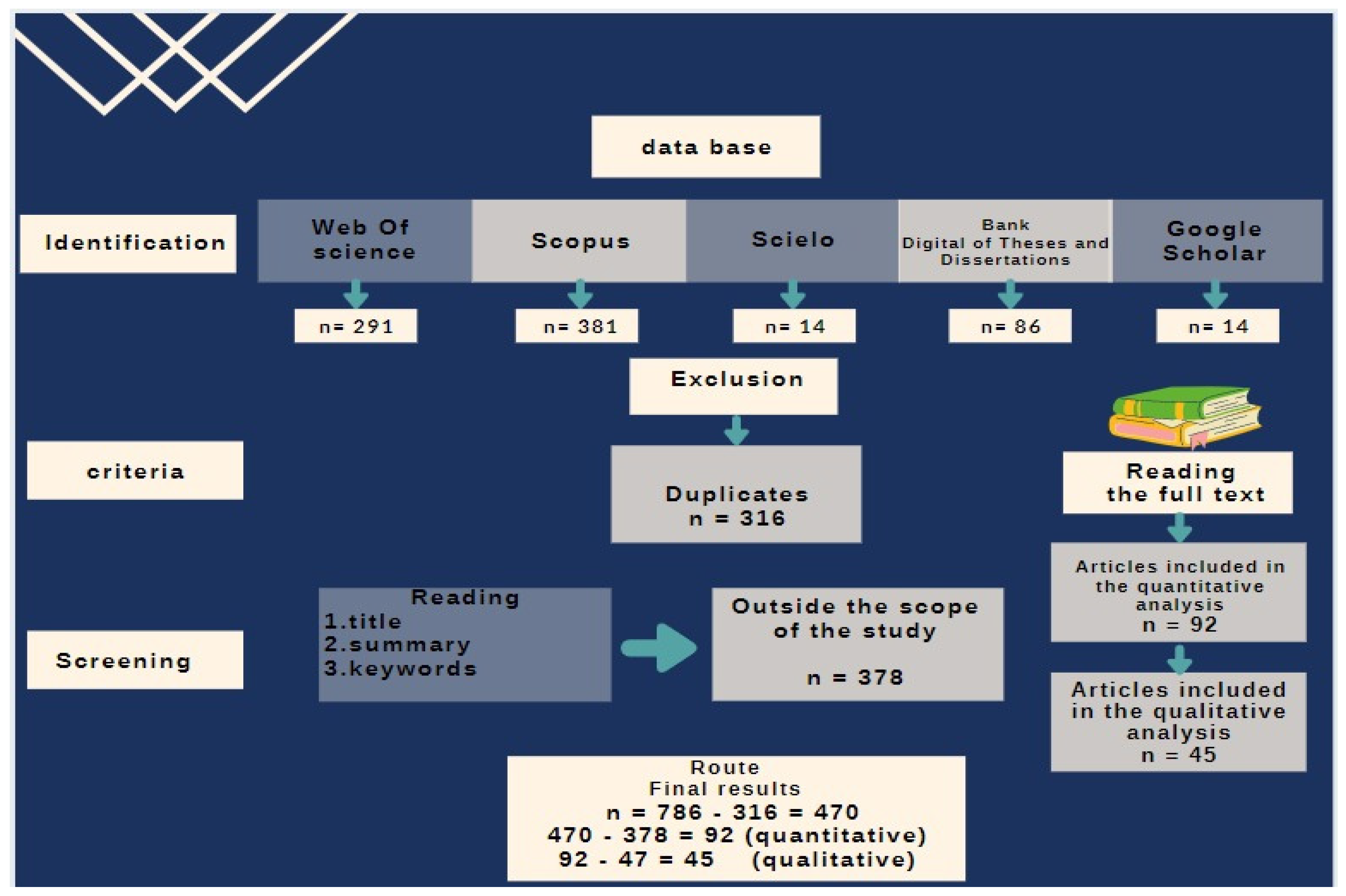
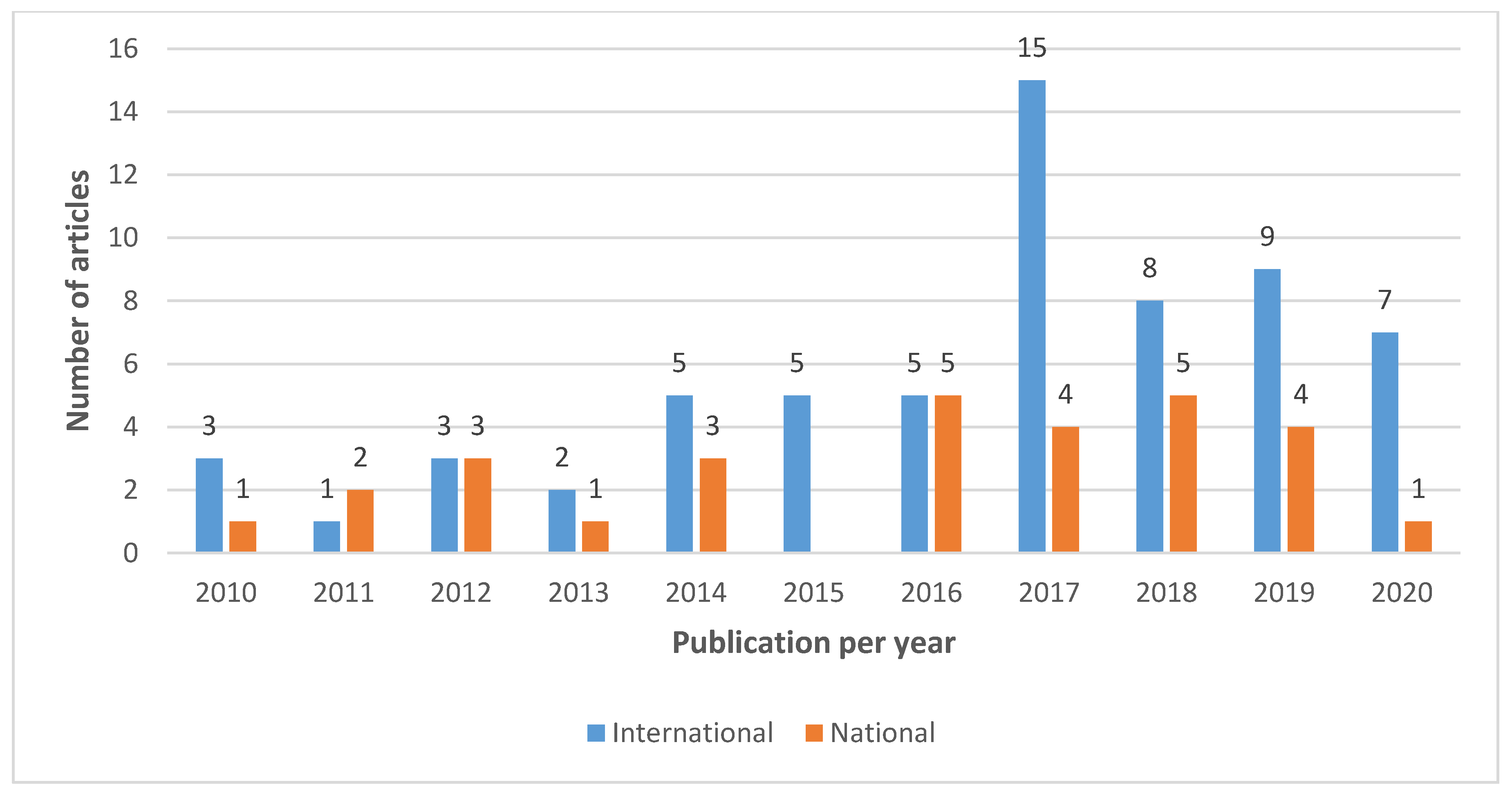
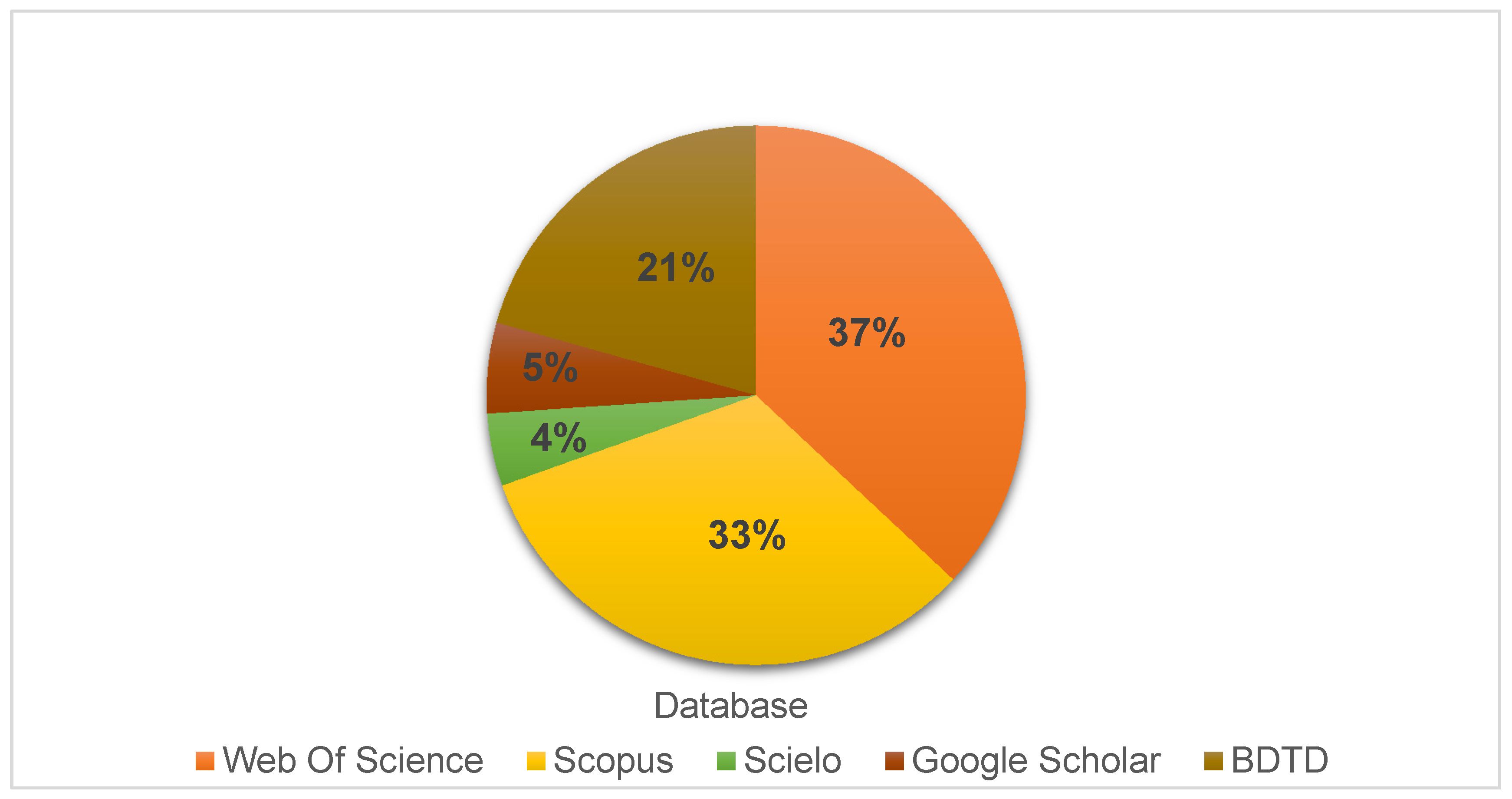
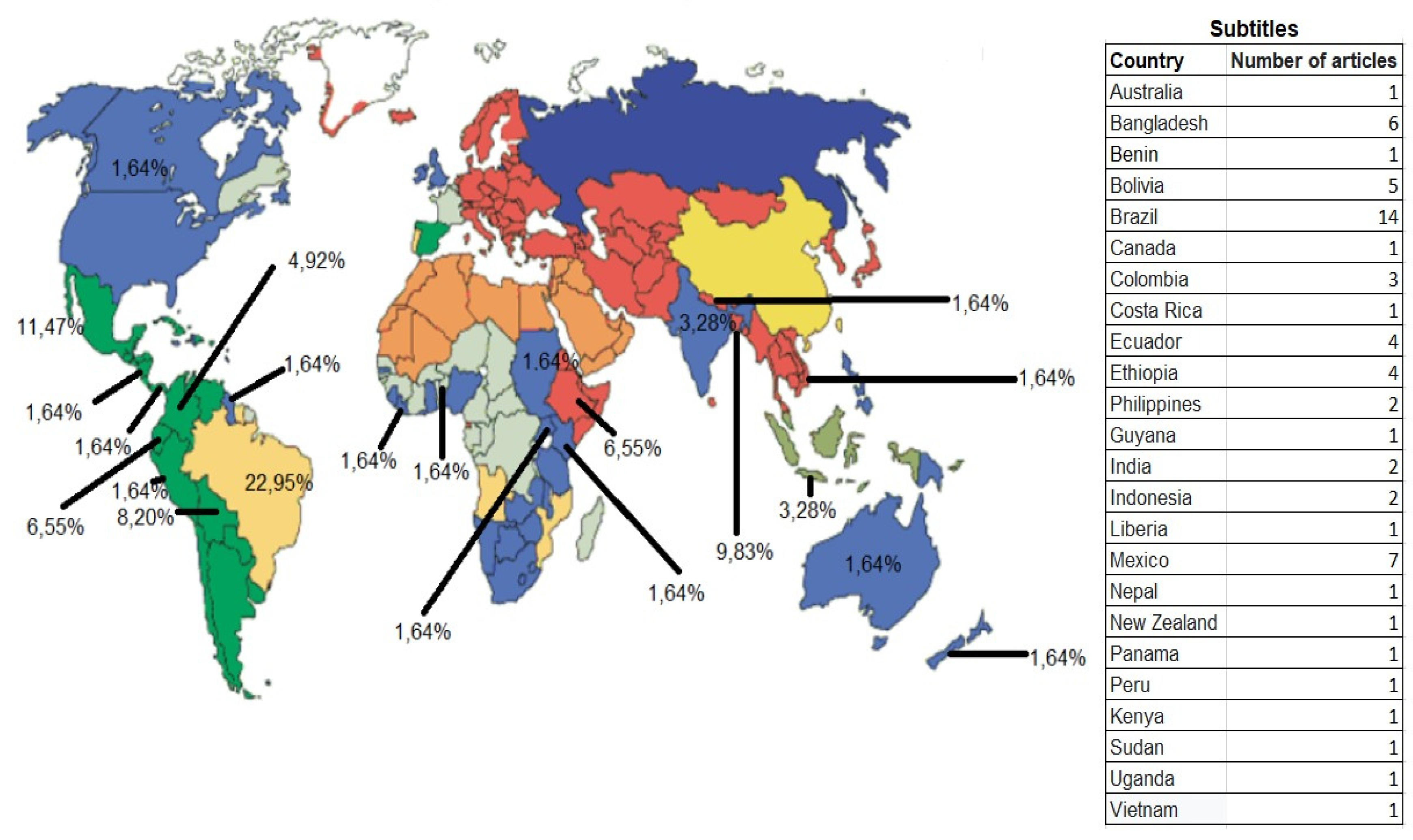
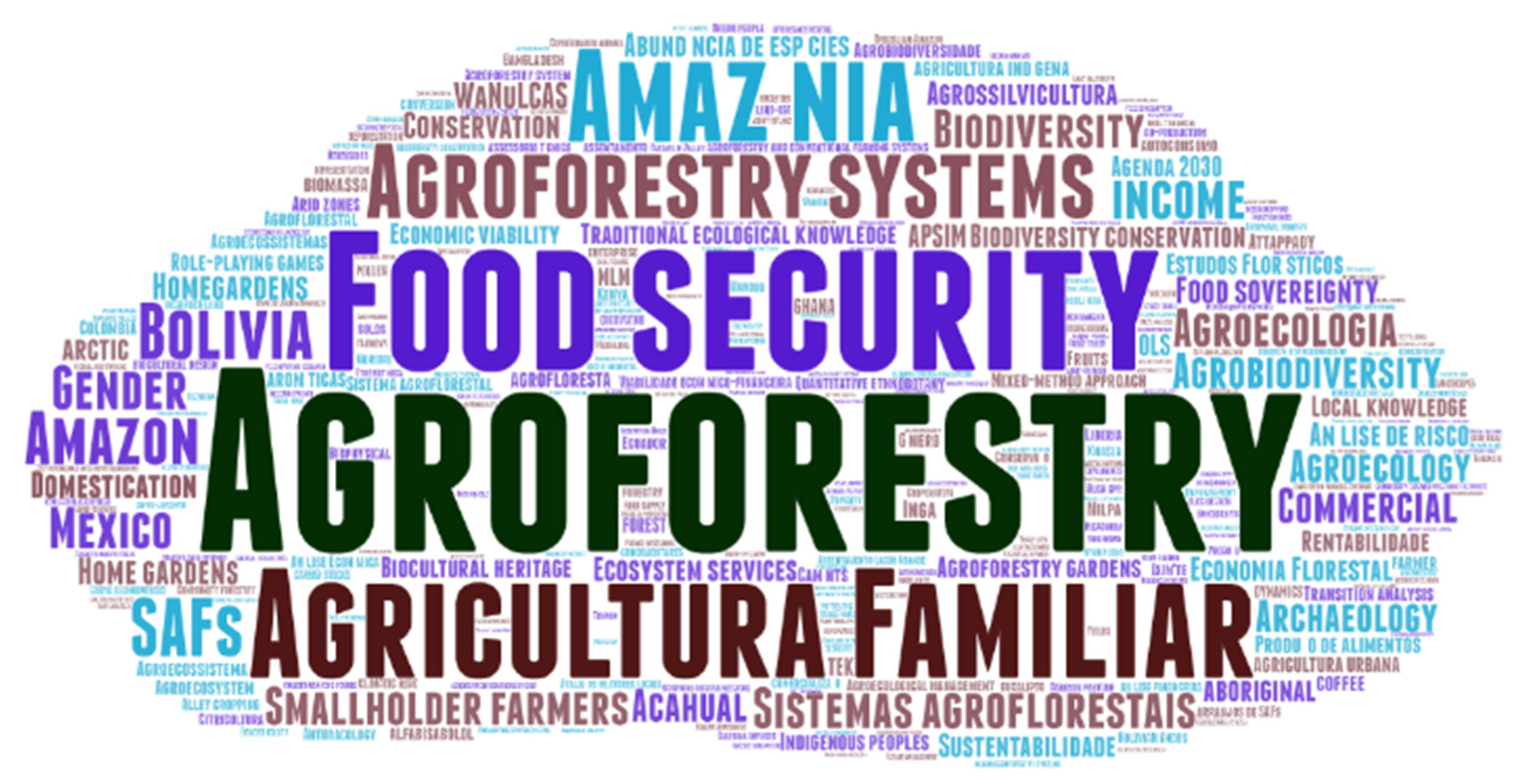
| Title | Citations |
|---|---|
| Field-scale modeling of tree–crop interactions: Challenges and development needs. | 53 |
| Teak agroforestry systems for livelihood enhancement, industrial timber production, and environmental rehabilitation. | 46 |
| Contribution of cocoa agroforestry systems to family income and domestic consumption: looking toward intensification. | 39 |
| The legacy of 4500 years of polyculture agroforestry in the eastern Amazon. | 31 |
| Selection of native trees for intercropping with coffee in the Atlantic Rainforest biome. | 22 |
| Plant management and biodiversity conservation in Nahuatl homegardens of the Tehuacan Valley, Mexico. | 21 |
| Traditional agroforestry systems and biodiversity conservation in Benin (West Africa). | 20 |
| Cocoa And Total System Yields of Organic And Conventional Agroforestry vs. Monoculture Systems In a Long-Term Field Trial In Bolivia. | 18 |
| Agroforestry species of the Bolivian Andes: An integrated assessment of ecological, economic, and socio-cultural plant values. | 18 |
| Enhancing the food security of upland farming households through agroforestry in Claveria, Misamis Oriental, Philippines. | 17 |
| Agroforestry Systems and Food Security | ||
| Journal | Number of Articles | JCR |
| Agroforestry Systems | 13 | 1.973 |
| Sustainability | 4 | 2.576 |
| Forest Policy And Economics | 2 | 3.139 |
| Land | 2 | 2.429 |
| Small-Scale Forestry | 2 | 1.453 |
| Agroforestry Systems and Indigenous Communities | ||
| Journal | Number of Articles | JCR |
| Agroforestry Systems | 5 | 1.973 |
| Sustainability | 3 | 2.576 |
| Forest Policy And Economics | 2 | 3.139 |
| Land | 2 | 2.429 |
| Agroforestry Systems and Economic Viability | ||
| Journal | Number of Articles | JCR |
| Cerne | 2 | 0.774 |
| Revista Árvore | 2 | 0.382 |
| Agroforestry Systems and the Role of Women | ||
| Journal | Number of Articles | JCR |
| Agroforestry Systems | 2 | 1.973 |
| Small-Scale Forestry | 2 | 1.453 |
Publisher’s Note: MDPI stays neutral with regard to jurisdictional claims in published maps and institutional affiliations. |
© 2021 by the authors. Licensee MDPI, Basel, Switzerland. This article is an open access article distributed under the terms and conditions of the Creative Commons Attribution (CC BY) license (https://creativecommons.org/licenses/by/4.0/).
Share and Cite
Gonçalves, C.d.B.Q.; Schlindwein, M.M.; Martinelli, G.d.C. Agroforestry Systems: A Systematic Review Focusing on Traditional Indigenous Practices, Food and Nutrition Security, Economic Viability, and the Role of Women. Sustainability 2021, 13, 11397. https://doi.org/10.3390/su132011397
Gonçalves CdBQ, Schlindwein MM, Martinelli GdC. Agroforestry Systems: A Systematic Review Focusing on Traditional Indigenous Practices, Food and Nutrition Security, Economic Viability, and the Role of Women. Sustainability. 2021; 13(20):11397. https://doi.org/10.3390/su132011397
Chicago/Turabian StyleGonçalves, Claudia de Brito Quadros, Madalena Maria Schlindwein, and Gabrielli do Carmo Martinelli. 2021. "Agroforestry Systems: A Systematic Review Focusing on Traditional Indigenous Practices, Food and Nutrition Security, Economic Viability, and the Role of Women" Sustainability 13, no. 20: 11397. https://doi.org/10.3390/su132011397
APA StyleGonçalves, C. d. B. Q., Schlindwein, M. M., & Martinelli, G. d. C. (2021). Agroforestry Systems: A Systematic Review Focusing on Traditional Indigenous Practices, Food and Nutrition Security, Economic Viability, and the Role of Women. Sustainability, 13(20), 11397. https://doi.org/10.3390/su132011397






